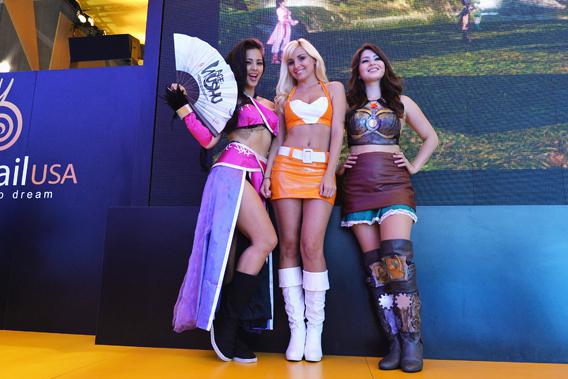The hardware is getting better, but the gaming world is still as sexist as ever. That was the takeaway from E3 2013, the video game industry’s biggest annual convention. First, feminist blogger Anita Sarkeesian observed that none of the Xbox One’s launch games have a female protagonist, and indignant gamers went to Twitter to excoriate her for it—which only appeared to prove her point. (Note to sexists who use Twitter: Be more creative! Jokes about “cooking and cleaning games” and dropping the C-bomb can only take you so far.) Then, Killer Instinct producer Torin Rettig (who is male) made a rape joke during a demonstration of the Xbox One launch title with Microsoft community coordinator Ashton Williams (who is female). “I can’t even block correctly, and you’re too fast,” Williams said. “Just let it happen,” Rettig replied. “It’ll all be over soon.”
Ugh.
Although Microsoft has since apologized for the gaffe, both incidents cast an ugly pall over the most exciting event of the year in gaming. They’re symptomatic of a seemingly permanent state of affairs in the gaming world. As Sarkeesian noted, video games continue to be almost entirely devoid of female leads. Publishers are reluctant to fund games with female leads, and when they do, they give them little or no marketing—which makes the conventional wisdom of “games with female protags don’t sell” (as one of Sarkeesian’s respondents put it) into more of a chicken-and-egg conundrum. Outside of a few franchises, such as Nintendo’s Metroid and Square Enix’s Tomb Raider, female characters take secondary roles: as helpers to the protagonist, victims, or villains.
Some companies, notably Nintendo, have made good examples of these secondary characters: Princess Peach is no longer confined to her tower, waiting for Mario to rescue her—she has a life of her own as a selectable character in the Mario Kart and Mario Party series, and in Super Princess Peach World, she saves Mario. Nintendo’s apparent desire to appeal to women jibes with its strategy of appealing to everyone.
The consumers reflect the games, and as a gamer myself, I resent it when anyone tries to paint millions of people with the same brush. A great deal of us are tolerant individuals who just want to be left alone to kill aliens in peace. But I also know that among us lurks a mass of cads who use the anonymity of the Internet to harass female players. If a female player speaks on a microphone during a game, she’ll be hounded by date requests and private messages, and often subject to the unified harassment of other players. Gamer lingo is inherently anti-female. Everyone is a “bitch” or a “slut” or a “whore.” (Sarkeesian was called one of these simply for making an empirical observation.) Rape as a gaming verb means “to destroy the other player.” Microsoft has promised to ban accounts engaged in harassment, but that’s fixing the problem after the fact, and will only filter out the worst of the bunch. That leaves a lot of players who traffic in the community’s sexism without even realizing it, as Rettig did at E3. (Will Microsoft ban Rettig from Xbox Live?)
It’s not surprising that publishers don’t think they can market female-lead games to this crowd. But why are gamers almost entirely men in the first place? There’s no neurological difference between males and females to explain the huge gender disparity, so here’s a historical theory: It’s because even the earliest games had an abundance of male protagonists and male appeals. They were designed by men, for men, and that’s why they continue to be. It’s not chicken-and-egg at all. It’s a chicken because it’s always been a chicken.
It follows, then, that women in the industry make significantly less money than men. Female developers endure gender-based discrimination and prejudice. The industry doesn’t attract female developers because they don’t play video games because video games aren’t made for them because the industry has always been run by men.
Mass-market entertainment industries have always been run by men, of course, and representation of women—even in the age of Katniss Everdeen and Daenerys Targaryen—continues to be an issue in all of them. But it’s strange that an industry as definitively innovative as the video game business continues to struggle with rank sexism. Yes, consumers reflect the games, and vice versa. But when industry leaders like Rettig are reflecting and reinforcing the worst attitudes in the gaming world, that’s a hall of mirrors from which there’s no apparent escape.
